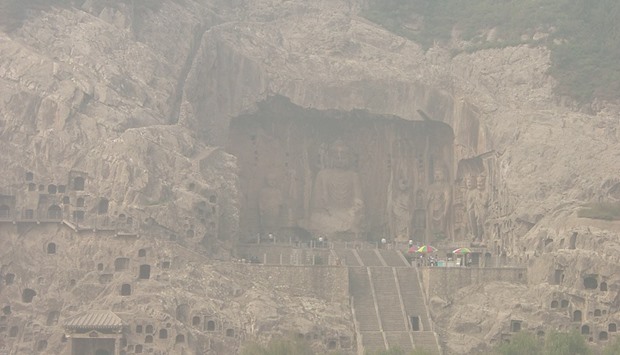Over the coming weeks we can expect to hear reports of the pollution in China becoming unbearable. It’s something that happens every year and it doesn’t appear to be getting any better. The reason for the sudden deterioration in air quality is partly due to the natural weather conditions of the region, but the central heating system used in parts of China also plays a very important role.
In winter, an area of high pressure dominates the weather across much of Asia. This forms because the huge Eurasian landmass gets very cold. Cold air is dense and heavy, so as the temperatures drop, the heavy air starts to push down on the earth. This causes the pressure to rise, and a large area of high pressure forms over the landmass. The sinking air acts as a lid on the atmosphere and the pollution is all trapped near the ground, unable to escape.
Regions of high pressure are also expected to bring periods of dry, still weather. This again works to make the air quality worse. A proper downpour would wash the pollution out of the atmosphere, and a strong wind would disperse the particles. However, with dry, settled weather the pollution that is created in the cities doesn’t clear. The fine particles hang in the air, whilst yet more pollution is created. The smog just continues to get worse.
On top of the natural climatic conditions, however, is the fact that it is now November, so the central heating system is being switched on. In China, it’s not the residents who decide when to switch on their heating, it’s the government. This may seem rather regimented to people who come from Europe or North America. After all, who’s to say that there isn’t going to be a cold snap before the government had planned to switch on the heating? After all, turning on the huge heating network isn’t as simple as flicking a switch, it takes weeks of planning and preparation.
The heating system is something that was set up by the government in the 1950s. It doesn’t cover the whole of the China, instead it was decided that the north of the country would have the heating and the south could do without.
My friend lives in Shenyang, a huge city with a population of eight million people, which is about 200 kilometres (125 miles) to the north of North Korea. The average maximum temperature in the city in January is -5C (23F), so clearly heating is essential. I visited my friend in October a few years ago. It was seriously cold, but the government had not yet deemed it necessary to put the heating on.
Even once the heating was switched on, my friend tells me that they have no control over how hot their apartments become. If their homes are situated near the main heating pipe, they will have apartments that are incredibly warm. One lady I met told me that her home was so hot that she had to have the window open at all times of the day and night, even when it was minus 20C (minus 4F) outside! However, if you are further away from the main heating line, the warmth can be insufficient, and you may have to spend the entire winter wrapped up in your coat indoors. Alarmingly, when you move into a new apartment, there is no way to tell how hot your radiators will become until the winter arrives.
The dividing line that separates which parts of China are heated and which are not runs along the Huai River and the Qinling Mountains, and the locals refer to it as the heating line. There’s no argument that the weather to the north of this line face cold winters, but those to the south are hardly tropical. Wuhan, the largest city in the Hubei province, is south of the heating line, but in January it sees an average night time temperature of -1C (30F). Certainly I’d like some method of heating if the temperature were to drop below freezing.
The cities to the north of the heating line may be provided with central heating, but there is a cost. The financial cost is heavily subsidised, but the real cost is to the health of the residents. The vast heating project is largely powered by coal. It’s estimated that the northern provinces burn over 700 million tons of coal per year for heating alone.
The vast consumption of coal during the winter months, combined with the natural geography of the country, explains why the pollution increases so markedly at the end of October and beginning of November. A study published in 2013 showed that particulate matter in the air to the north of Huai River was 55 percent higher than in the south and this even had a knock on effect on the average life expectancy, which is five years lower for people in the north.
Clearly a source of heat is something that is essential in China, where the temperatures can drop a long way below freezing. However, finding a method of heating homes which doesn’t rely on coal would be beneficial to the health of the residents. It may be time for the government to encourage individual heating in people’s homes, or look for cleaner sources of energy.

A 2006 file photo of Longmen Caves in Luoyang, Henan province. This view from across the valley is covered by a foul blanket of choking haze. Pollution in China gets worse in winter every year, and it doesn’t appear to be getting any better. Photo by G41rn8/Wikipedia
